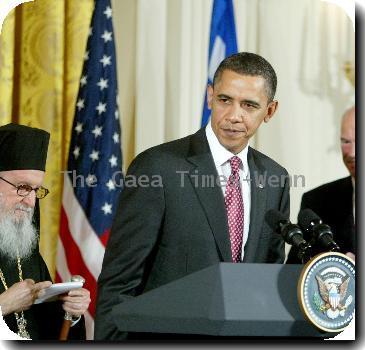Scientists say Iceland volcano activity increases, more travel disruptions feared
By Paisley Dodds, APSaturday, April 17, 2010
Iceland volcano activity increases
LONDON — A geologist says activity has increased at an erupting Icelandic volcano, causing an ash plume to rise some 8.5 kilometers (5.3 miles) into the air.
Magnus Tumi Gudmundsson of the University of Iceland says winds have cleared visibility for scientists and Saturday will be the first day they can fly above the volcano to assess the activity.
Once scientists determine how much ice has melted, it will be easier to say how long the eruption could last.
An ash plume that has disrupted travel across Europe has been caused by hot magma being cooled quickly by the melting ice cap.
Gudmundsson says as long as there is enough ice, more plumes could form — causing even more travel disruption.
THIS IS A BREAKING NEWS UPDATE. Check back soon for further information. AP’s earlier story is below.
LONDON (AP) — Officials further extended no-fly restrictions over Europe Saturday as a vast, invisible plume of grit continued to billow out of an Icelandic volcano and drift across the continent.
The flight ban seemed likely to disrupt world leaders’ plans to attend Sunday’s state funeral for Polish President Lech Kaczynski and his wife Maria in the southern city of Krakow.
South Korean Prime Minister Chung Un-chan was the first to announce he was canceling his trip to Poland. An 11-member delegation led by Chung had planned to leave on Saturday, said Shin Bu-seop, an official of the prime minister’s office.
So far, President Barack Obama, Russian President Dmitry Medvedev and German Chancellor Angela Merkel are still on the list of attendees. Kaczynski’s family insisted Friday they wanted the funeral to go forward as planned but there was no denying the ash cloud was moving south and east.
On Saturday, British officials extended their closure of airspace until at least 7 p.m. (1800 GMT; 2 p.m. EDT), and reintroduced the ban over Scotland and northern England. The Belgian, French and Swiss governments extended their ban until the same time.
Italian aviation authorities were closing airspace in northern Italy on Saturday until midday (1000 GMT; 6 a.m. EDT), with airports in Milan and Venice to close.
Germany shut down all of its international airports, including Munich and Frankfurt, Europe’s third-busiest terminal, until at least 2 p.m. (1200 GMT; 8 a.m. EDT). National carrier Lufthansa said it was canceling all flights through 8 p.m. (1800GMT; 2 p.m. EDT) Saturday.
Serbia also closed a small strip of its airspace in the north of the country and said it could close more later.
Australia’s Qantas canceled all flights to Europe on Saturday, and passengers were being offered refunds or seats on the next available flight. The airline said it was not known when flights would resume. Cathay Pacific was already canceling some Europe-bound flights leaving Hong Kong on Sunday.
Fears that microscopic particles of highly abrasive ash could endanger passengers by causing aircraft engines to fail have shut down air space at one time or another over much of Europe in recent days.
“I’ve been flying for 40 years but I’ve never seen anything like this in Europe,” said Swedish pilot Axel Alegren, after landing his flight from Kabul, Afghanistan, at Munich Airport; he had been due to land at Frankfurt but was diverted.
“What we’re experiencing is very, very unique. Basically Europe is turning into a no-fly zone right now, like the U.S. after 9/11,” Alegren said. “It’s going to be chaos in the next few days but it will also be something that nobody will ever forget in aviation.”
The air traffic agency Eurocontrol said about 16,000 of Europe’s usual 28,000 daily flights were canceled — twice as many as were canceled a day earlier.
U.S. airlines canceled 280 of the more than 330 trans-Atlantic flights of a normal day, and about 60 flights between Asia and Europe were canceled.
The International Air Transport Association says the volcano is costing the industry at least $200 million a day.
Southern Iceland’s Eyjafjallajokull (ay-yah-FYAH’-plah-yer-kuh-duhl) volcano began erupting for the second time in a month on Wednesday, sending ash several miles (kilometers) into the air. Winds pushed the plume south and east across Britain, Ireland, Scandinavia and into the heart of Europe.
Gray ash settled in drifts near the glacier, swirling in the air and turning day into night. Authorities told people in the area with respiratory problems to stay indoors, and advised everyone to wear masks and protective goggles outside.
In major European cities, travel chaos reigned. Extra trains were put on in Amsterdam and lines to buy train tickets were so long that the rail company handed out free coffee.
Train operator Eurostar said it was carrying almost 50,000 passengers between London, Paris and Brussels. Thalys, a high-speed venture of the French, Belgian and German rail companies, was allowing passengers to buy tickets even if trains were fully booked.
Ferry operators in Britain received a flurry of bookings from people desperate to cross the English Channel to France, while London taxi company Addison Lee said it had received requests for journeys to cities as far away as Paris, Milan, Amsterdam and Zurich.
The disruptions hit tourists, business travelers and dignitaries alike.
German Chancellor Angela Merkel had to go to Portugal rather than Berlin as she flew home from a U.S. visit. Norwegian Prime Minister Jens Stoltenberg managed to get a flight to Madrid from New York but was still not sure when or how he would get back home.
The military also had to adjust. Five German soldiers wounded in Afghanistan were diverted to Turkey instead of Germany, while U.S. medical evacuations for troops in Iraq and Afghanistan are being flown directly from the warfronts to Washington rather than to a care facility in Germany. The U.S. military has also stopped using temporarily closed air bases in the U.K. and Germany.
Aviation experts said it was among the worst disruptions Europe has ever seen.
In Iceland, torrents of water carried away chunks of ice the size of small houses on Thursday as hot gases melted the glacier over the volcano. Sections of the country’s main ring road were wiped out by the flash floods.
More floods from melting waters are expected as long as the volcano keeps erupting — and in 1821, the same volcano managed to erupt for more than a year.
Small amounts of ash settled in northern Scotland and Norway, but officials said it posed little threat to health.
Iceland, a nation of 320,000 people, sits on a large volcanic hot spot in the Atlantic’s mid-oceanic ridge and has a history of devastating eruptions. One of the worst was the 1783 eruption of the Laki volcano, which spewed a toxic cloud over Europe, killing tens of thousands.
Associated Press Writers Naomi Koppel in London, Geir Moulson in Berlin, Angela Charlton in Paris, Raf Casert in Brussels, Slobodan Lekic in Munich and Kwang-Tae Kim in Seoul, South Korea, contributed to this report.
Tags: Afghanistan, Air Travel Disruptions, Asia, Barack Obama, Central Asia, Earth Science, Eastern Europe, England, Europe, Funerals And Memorial Services, Germany, Iceland, Iceland-volcano, Italy, London, Milan, Munich, North America, Norway, Poland, Scotland, State Funerals, Transportation, United Kingdom, United States, Vulcanology, Western Europe

